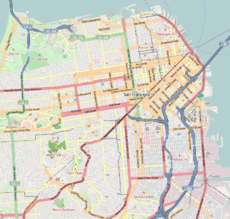Telegraph Hill, San Francisco
| Telegraph Hill | |
|---|---|
| Neighborhood | |

A view of Telegraph Hill from a boat in the San Francisco Bay.
|
|
| Location within Central San Francisco | |
| Coordinates: 37°48′09″N 122°24′21″W / 37.802409°N 122.40587°W | |
| Country |
|
| State |
|
| City-county | San Francisco |
| Government | |
| • Supervisor | Aaron Peskin |
| • State Assembly | David Chiu (D) |
| • State Senator | Scott Wiener (D) |
| • U. S. Rep. | Nancy Pelosi (D) |
| Area | |
| • Total | 0.215 sq mi (0.56 km2) |
| • Land | 0.215 sq mi (0.56 km2) |
| Population (2008) | |
| • Total | 8,177 |
| • Density | 38,055/sq mi (14,693/km2) |
| ZIP Code | 94133, 94111 |
| Area codes | 415/628 |
| Reference no. | 91 |
Telegraph Hill (elev. 275 ft (84 m)) is a neighborhood in San Francisco, California. It is one of San Francisco's 44 hills, and one of its original "Seven Hills".
The San Francisco Chronicle defines the Chinatown, North Beach, and Telegraph Hill areas as bounded by Sacramento Street, Taylor Street, Bay Street, and the water.
The neighborhood is bounded by Vallejo Street to the south, Sansome Street to the east, Francisco Street to the north and Powell Street and Columbus Avenue to the west, where the southwestern corner of Telegraph Hill overlaps with the North Beach neighborhood.
Originally named Loma Alta ("High Hill") by the Spaniards, the hill was then familiarly known as Goat Hill by the early San Franciscans, and became the neighborhood of choice for many Irish immigrants. From 1825 through 1847, the area between Sansome and Battery, Broadway and Vallejo streets was used as a burial ground for foreign non-Catholic seamen.
The hill owes its name to a semaphore, a windmill-like structure erected in September 1849, for the purpose of signaling to the rest of the city the nature of the ships entering the Golden Gate. Atop the newly built house, the marine telegraph consisted of a pole with two raisable arms that could form various configurations, each corresponding to a specific meaning: steamer, sailing boat, etc. The information was used by observers operating for financiers, merchants, wholesalers and speculators. Knowing the nature of the cargo carried by the ship they could predict the upcoming (generally lower) local prices for those goods and commodities carried. Those who did not have advance information on the cargo might pay a too-high price from a merchant unloading his stock of a commodity — a price that was about to drop. On October 18, 1850, the ship Oregon signaled to the hill as it was entering the Golden Gate the news of California's recently acquired statehood.
...
Wikipedia

